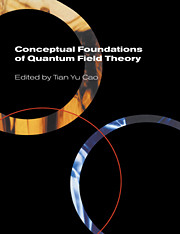Book contents
- Frontmatter
- Contents
- List of contributors
- Preface
- Photographs of the conference
- Introduction: Conceptual issues in quantum field theory
- Part One Philosophers' interest in quantum field theory
- Part Two Three approaches to the foundations of quantum field theory
- Part Three
- Part Four Mathematics, statistics and quantum field theory
- Part Five Quantum field theory and space-time
- Part Six
- Part Seven Renormalization group
- Part Eight Non-Abelian gauge theory
- Part Nine The ontology of particles or fields
- 22 The ineliminable classical face of quantum field theory
- 23 The logic of quanta
- 24 Do Feynman diagrams endorse a particle ontology? The roles of Feynman diagrams in S-matrix theory
- 25 On the ontology of QFT
- Part Ten
- Name index
- Subject index
24 - Do Feynman diagrams endorse a particle ontology? The roles of Feynman diagrams in S-matrix theory
Published online by Cambridge University Press: 22 September 2009
- Frontmatter
- Contents
- List of contributors
- Preface
- Photographs of the conference
- Introduction: Conceptual issues in quantum field theory
- Part One Philosophers' interest in quantum field theory
- Part Two Three approaches to the foundations of quantum field theory
- Part Three
- Part Four Mathematics, statistics and quantum field theory
- Part Five Quantum field theory and space-time
- Part Six
- Part Seven Renormalization group
- Part Eight Non-Abelian gauge theory
- Part Nine The ontology of particles or fields
- 22 The ineliminable classical face of quantum field theory
- 23 The logic of quanta
- 24 Do Feynman diagrams endorse a particle ontology? The roles of Feynman diagrams in S-matrix theory
- 25 On the ontology of QFT
- Part Ten
- Name index
- Subject index
Summary
Introduction
Feynman diagrams have long been a staple tool for theoretical physicists. The line drawings were originally developed in the late 1940s by the American physicist Richard Feynman for the perturbative study of quantum electrodynamics, and are taught today to students of quantum field theory in much the same manner as Feynman originally designed them. Yet for a time during the 1950s and 1960s, Feynman diagrams became an equally indispensable tool in the hands of quantum field theory's rivals - particle physicists following the lead of Lev Landau and Geoffrey Chew, who aimed to construct a fully autonomous S-matrix theory built around a scaffolding of Feynman diagrams, but conspicuously lacking all field-theoretic notions of quantum fields or Hamiltonians. By the early 1960s, Chew and his collaborators had commandeered the field-theoretic diagrams while denouncing quantum field theory as being both bankrupt and dead. In the process, Feynman diagrams were re-invested with distinct meanings by the S-matrix theorists, and were taken to represent a fundamentally different basis for studying the constitution and interactions of particles.
There was a series of steps by which S-matrix theorists crafted an autonomous diagrammatic method, some of which we consider here. First came Geoffrey Chew's 1958 particle-pole conjecture. This work was soon extended by Chew in collaboration with Francis Low in their 1959 work on scattering off of unstable targets.
Information
- Type
- Chapter
- Information
- Conceptual Foundations of Quantum Field Theory , pp. 343 - 356Publisher: Cambridge University PressPrint publication year: 1999
Accessibility standard: Unknown
Why this information is here
This section outlines the accessibility features of this content - including support for screen readers, full keyboard navigation and high-contrast display options. This may not be relevant for you.Accessibility Information
- 2
- Cited by
